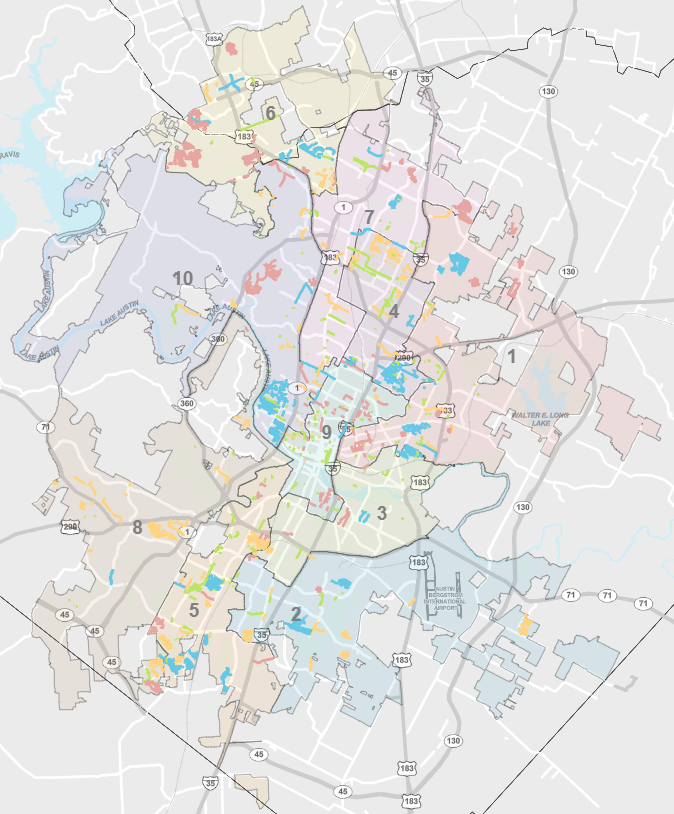Austin has 8,000 lane miles of streets and 2,500 centerline miles. Austin Transportation and Public Works uses various strategies to improve and maintain City of Austin-owned roadway surfaces. Scheduled preventative maintenance helps prolong the lifespan of these surfaces by protecting them from aging, cracking, deterioration, and water infiltration. Prolonging the life of our city streets saves time and taxpayer money by intervening before full reconstruction is needed.
What streets will be paved next?
Use the interactive Street Maintenance map to see what streets are scheduled for maintenance this year. The map reflects our most current research and is updated annually . Our goal is to maintain at least 80 percent of Austin’s streets in fair or better condition.
Five Types of Pavement Treatment
Our five main treatment types include sealcoat, overlay, slurry seal, crack seal and fog seal. The City of Austin uses a Pavement Information System (PMIS) to track pavement inventory and performance, which helps to assign appropriate treatment types at various locations.
- Sealcoat
-
One of the more notable treatment types we use on streets is sealcoat. This is a cost-effective maintenance solution that is applied from April to October each year.
To apply, crews spray an oil mixture on the road then spread and roll the gravel mixture into place. Finally, they sweep up excess gravel, resulting in a smoother surface that eliminates the hairline cracks that lead to potholes.
Residents who live along streets identified for sealcoat treatment will receive a notice before scheduled work. These residents will be asked to move vehicles away from streets scheduled for maintenance for two days.
Streets can be used immediately after treatment, which is typically done in 30 minutes. However, hard braking or turning over newly-sealcoated streets should be avoided, since this can cause an increased amount of small gravel particles to break loose from the road before the treatment cures. Crews will return for additional sweeping of loose gravel if needed. Residents can expect loose gravel to settle in roughly 4-6 weeks.
Sealcoat is not applied in cul-de-sacs due to sharp turning by vehicles in these areas. Instead, a slurry seal treatment may be applied in cul-de-sacs.
- Overlay
-
Mill and overlay involves grinding up the existing asphalt and base material, removing it, and applying new pavement. The result will be a much smoother driving surface. Overlay consists of a single layer of hot mix asphaltic concrete used to level, waterproof, and restore the original street shape and ride.
Mill and Overlay FAQ
1) What does “Mill and Overlay” mean?
Mill and Overlay involves grinding up the existing asphalt material, removing it, and applying new hot mix asphalt surface layer. The result will be a much smoother driving surface.
2) Why is Mill and Overlay important?
The major benefits of Mill and Overlay are to reduce surface roughness and address minor deformations, cracking, and irregularities in the pavement surface resulting in a much smoother ride quality and longer overall pavement life. This type of resurfacing treatment prevents the City from having to perform a full street reconstruction, which can be costly and time consuming.
3) What is the process?
The mill and overlay process is performed in two phases. Phase one involves the grinding or milling and removal of the asphalt layer. The second phase involves placing a new layer of asphalt concrete surface. In normal conditions, it is a two day operation. As always, schedules are projected as accurately as possible but are subject to change due to the nature of maintenance construction and weather.
4) How will this affect traffic and street access?
The street will remain open to traffic; however, access to driveways will not be available when the new pavement is being placed in front of the driveway. We encourage drivers to use extra caution while in the work zone. Once the material is placed, rolled and compacted, vehicles may drive (slowly) on the new pavement. Following the street resurfacing work, crews will install pavement markings and striping within two weeks.
5) How will I be notified if mill and overlay is scheduled on my street?
Notifications are delivered door-to-door to alert residents that crews will be on your street to perform routine street maintenance. The notice is a door hanger letter that will be delivered to the affected homes/properties about a week in advance to remind residents that crews will be on your street and provide details on the schedule and the process. There will be “no parking” signs posted along the street, reminding residents not to park within the work-zone between the posted work hours.
6) Why are you working on to my street?
Mill and overlay is needed to preserve the underlying pavement structure and to provide smoother ride quality. Streets are selected based on pavement condition.
7) Are you going to fix my driveway?
It is the property owner’s responsibility to maintain and repair the driveway. Mill and Overlay is strictly for street maintenance only.
8) Why did you tow my car?
Entire street surface is being replaced , and the full width is needed for the equipment and passing vehicles . Affected residents are notified in advance to remove parked cars. Any car(s) left on the street(s) on the day of the scheduled work will be towed around the corner so that scheduled mill and overlay work can be completed.
9) Approximately what time will crews be working on my street?
The crews work during daylight hours from 7:00 AM-5:00 PM on weekdays. Depending on the type of street, work on weekends or at night may be necessary.
10) Can I drive in and out of my driveway?
Yes, during milling and paving operations City crews will assist you. For yours and the City crew’s safety, we request that you do not drive while crews are working within close vicinity of your driveway. However, in case of urgent need should you need to get in and out of your driveway, there will be crews to assist you.
11) Will my trash be picked up?
Most of milling and paving work is usually scheduled outside of routine trash pick-up days/schedule with little or no conflicts with the trash pick-up schedule.
12) Why are we working on weekends?
On some of the City of Austin arterial and collector streets, preventative maintenance work can only be scheduled on weekends. Weekend works ensures minimal traffic impact to residents and businesses. The City will always notify the public before weekend work is scheduled on your street.
13) How long will it take before I can drive on the freshly paved street?
As soon as the job is complete you can drive on the freshly resurfaced street. Do not drive on the fresh pavement until it is rolled over and compacted (approximately 45 minutes).
14) How often does the City of Austin perform preventive maintenance on a street?
Preventive maintenance in the form of Mill and Overlay, Thin Surface Treatments and Crack seals are scheduled as appropriate based on the street condition , planned utility work , and time since last maintenance.
15) After you pave the street, why do you come back and tear it up?
Prior to scheduling paving on any street, the City coordinates scheduled work with both city and private utilities. As public right-of-ways are shared by many utilities, there is always a chance of some unforeseen event such as leaks or ruptures in water, wastewater, gas lines, or new service requests, that may affect the street.
- Slurry Seal
-
A slurry seal is a mixture of asphalt, water, fine aggregate, and mineral filler withy a creamy fluid-like appearance. Slurry seals fill existing pavement surface defects as a preparatory treatment for other maintenance treatments. This treatment is also used in cul-de-sacs.
- Crack Seal
-
Crack seal consists of sealing the cracks in the pavement with a sealant or asphalt-sealing product to prevent moisture from entering into the base and subgrade material.
- Fog seal
-
Fog seal is a light application of diluted asphalt mixture. The seal is used to renew aged asphalt surfaces and to seal small cracks and surface voids.
Report an Issue
To report a pothole or other street maintenance issue, call 3-1-1, visit the Austin 3-1-1 website or download the 3-1-1 app.
Related Links
Pavement Preventative Maintenance FAQ
Mill and Overlay Overview



